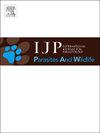Different age, different blood parasites - Acrocephalus species and their haemosporidian parasites during autumn migration in Central Europe
IF 2.2
3区 医学
Q3 ECOLOGY
International Journal for Parasitology-Parasites and Wildlife
Pub Date : 2025-06-01
DOI:10.1016/j.ijppaw.2025.101085
引用次数: 0
Abstract
In migratory passerines, the timing of the different phases of the migratory journey is of great importance for the survival prospect of the individuals. Haemosporidian infections could weaken the immune system, decelerate the ability of fat accumulation and potentially influence the migratory behaviour. As a large number of blood parasites is host-generalist there is a potential for cross-species and cross-population transmission with different parasite species during the migratory route of the passerines. In addition, resident birds also interact with different parasite fauna when migratory birds arrive back from their migratory route, therefore, it is important to study what kind of blood parasites migratory birds carry.
We screened three long-distant migratory Acrocephalus species during autumn migration in two years. We found that in reed and sedge warblers the overall prevalence of blood parasites was significantly higher in adults than in juveniles, and the prevalence of Haemoproteus infections was higher than that of the Plasmodium in adults. In contrast, Plasmodium infections dominated in juveniles in all the three species. The odds of catching infected juvenile individuals increased during the autumn migration, but infections had no significant effect on the actual body mass of the birds. These results could imply age-related differences in the probability of getting infected with different blood parasite genera. Sampling during migration and exploring the potential differences in parasite species composition and their effects on the migratory behaviour in different age groups can provide valuable insight in answering these questions.

不同的年龄,不同的血寄生虫——中欧秋季迁徙中的顶头虫及其血孢子虫
在迁徙的雀形目动物中,不同迁徙阶段的时间对个体的生存前景至关重要。血孢子虫感染可以削弱免疫系统,减缓脂肪积累的能力,并可能影响迁移行为。由于大量血寄生虫具有寄主通用性,因此在雀形目动物的迁徙路线中,存在与不同寄主物种跨种、跨种群传播的可能性。此外,当候鸟从迁徙路线返回时,留鸟还与不同的寄生动物群相互作用,因此研究候鸟携带了何种血寄生虫具有重要意义。在两年的秋季迁徙中,我们筛选了三种远距离迁徙的头甲动物。结果表明,芦苇和莎草莺血寄生虫的总体流行率在成虫中明显高于幼虫,且嗜血杆菌感染的流行率高于疟原虫。相比之下,在所有三个物种的幼体中,疟原虫感染占主导地位。在秋季迁徙期间,捕获受感染的幼鸟的几率增加了,但感染对鸟类的实际体重没有显著影响。这些结果可能意味着感染不同血液寄生虫属的可能性存在与年龄相关的差异。在迁徙过程中进行采样,探索不同年龄段寄生虫物种组成的潜在差异及其对迁徙行为的影响,可以为回答这些问题提供有价值的见解。
本文章由计算机程序翻译,如有差异,请以英文原文为准。
求助全文
约1分钟内获得全文
求助全文
来源期刊

International Journal for Parasitology-Parasites and Wildlife
Medicine-Infectious Diseases
CiteScore
3.80
自引率
5.60%
发文量
113
审稿时长
45 days
期刊介绍:
The International Journal for Parasitology: Parasites and Wildlife (IJP-PAW) publishes the results of original research on parasites of all wildlife, invertebrate and vertebrate. This includes free-ranging, wild populations, as well as captive wildlife, semi-domesticated species (e.g. reindeer) and farmed populations of recently domesticated or wild-captured species (e.g. cultured fishes). Articles on all aspects of wildlife parasitology are welcomed including taxonomy, biodiversity and distribution, ecology and epidemiology, population biology and host-parasite relationships. The impact of parasites on the health and conservation of wildlife is seen as an important area covered by the journal especially the potential role of environmental factors, for example climate. Also important to the journal is ''one health'' and the nature of interactions between wildlife, people and domestic animals, including disease emergence and zoonoses.
 求助内容:
求助内容: 应助结果提醒方式:
应助结果提醒方式:


